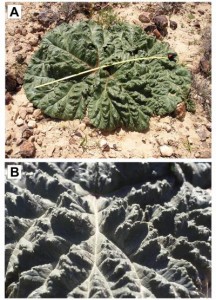World's first self-watering desert plant discovered

For years scientists have wondered how the desert rhubarb manages to grow leaves that reach a diameter of up to one meter while other desert plant species typically have small and spiky leaves.
Now, researchers from the University of Haifa-Oranim, have managed to decipher the unique self-watering mechanism of this plant in the Negev desert, which covers half of Israel. The desert rhubarb is the first example of a self-irrigating plant worldwide.

Researchers from the University of Haifa-Oranim have managed to decipher the unique self-watering mechanism of this plant in the Negev desert, which harvests 16 times more water than other plants in the region (Credit: Prof. Gidi Ne'eman, University of Haifa)
The rare plant, scientifically known as Rheum palaestinum, harvests 16 times the amount of water than otherwise expected for a plant in this region based on the quantities of rain in the desert. The average precipitation in the Negev is only 75 mm per year, yet the plant is able to harvest quantities of water that are closer to that of Mediterranean plants, reaching up to 426 mm per year. It is quite remarkable considering that even during the rainy season, the region’s light rainfalls often don’t penetrate the rocky soil of the desert.
According to the researchers, the unique leaves are covered with a waxy cuticle and have deep and wide depressions that create a "channeling" mountain-like system by which the rain water is channeled toward the ground surrounding the plant's deep root. Other desert plants simply suffice with the rain water that penetrates the ground in its immediate surroundings.
"We measured the seasonal course of leaf growth, examined the area of wet soil surrounding the root after actual and simulated rain, and modeled the water harvesting capacity using the plant leaf area and the weekly precipitation. We show that even in the slightest rains, water flows above the veins to the leaf’s base where it irrigates the vertical root," says the abstract of a paper written by Prof. Simcha Lev-Yadun, Prof. Gidi Ne'eman and Prof. Gadi Katzir and published in Naturwissenschaften, a German journal of ecology.
The team found that even during a light rain the plant’s water absorption mechanism allowed for water to channel downward and infiltrate the soil 10 times deeper around its root then in surrounding areas. Under the experimental conditions, water penetrated the ground only as deep as 1 centimeter.
"We know of no other plant in the deserts of the world that functions in this manner," the researchers concluded.